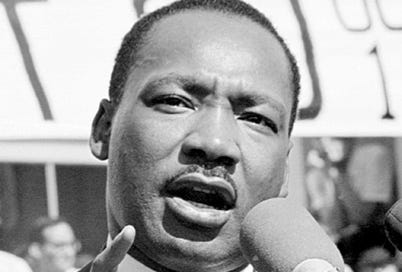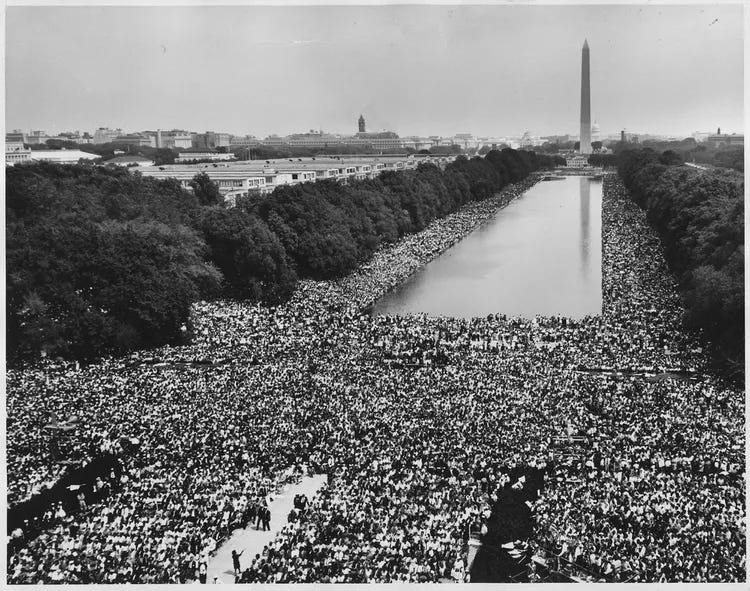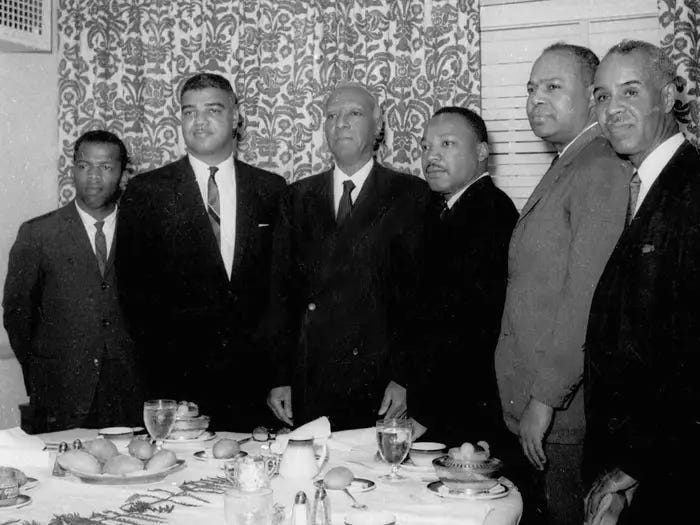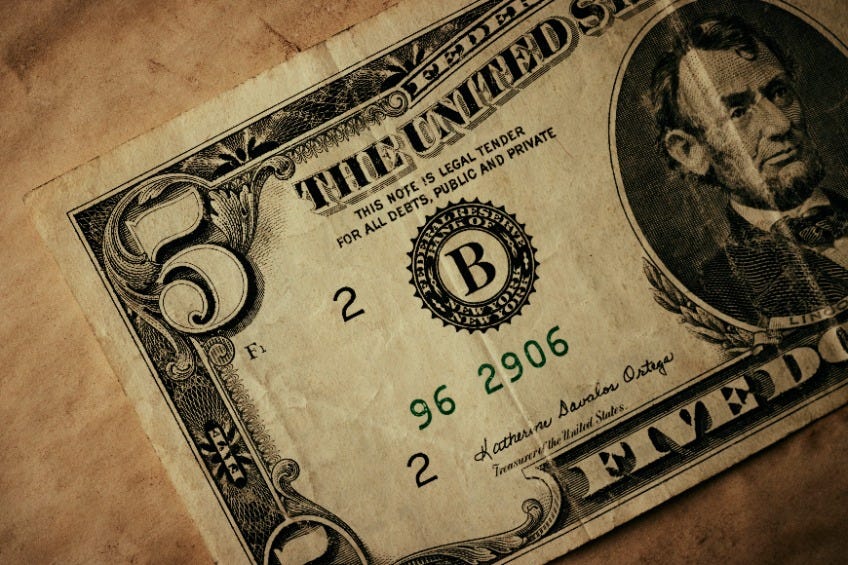TIBH: The True Context of the “I Have A Dream” Speech
Many people do not know the real purposes and meaning of the speech
Issue #456 Today In Black History, January 15, 2024
This article, published in place of our regular Today In Black History, is a little longer than usual to honor Dr. King and tell the whole story.
A previous version of this article was originally published on January 16, 2023.
Today, the third Monday of January is the official federal holiday celebrating the life and legacy of civil rights activist Rev. Dr. Martin Luther King, Jr. The holiday is also known as the “MLK Day of Service.” Dr. King was born in Atlanta, Georgia on January 15, 1929, the same year that Anne Frank and Barbara Walters were born. He died by assassination in Memphis, Tennessee on April 4, 1968. He was 39 years old at the time of his death.
The struggle to make Dr. King’s birthday an official government holiday
For years after Dr. King’s death, many proposals were submitted to make his birthday an official holiday, including a bipartisan bill submitted to Congress in 1979 by Representative John Conyers (D-MI) and Senator Edward Brooke (R-MA).
Many of the arguments that were posed against the bill argued that it would be too expensive to add another paid federal holiday and that a private citizen should not have a holiday named for them. (That never stopped Congress from approving a national Federal holiday for Christopher Columbus who wasn’t even an American citizen and never even stepped foot on what would become the United States of America.)
Senator Jesse Helms (R-NC) questioned whether King was important enough for a federal holiday and submitted a 300-page document to the Senate accusing Dr. King of being a communist, a Marxist, and being against the Vietnam War. Senator Daniel Patrick Moynihan (D-NY) declared Helms’ document a packet of filth, threw it on the Senate floor, and stomped on it.
Meanwhile, the King Center reached out to the corporate community and the general public for support. Award-winning musician Stevie Wonder released his single “Happy Birthday,” in 1980 and also hosted the Rally for Peace Press Conference in 1981. Six million signatures were collected on a petition to Congress to pass the law, the largest petition in favor of an issue in American history to date.
President Ronald Reagan initially opposed the idea of a federal holiday, citing the cost, but after the bill finally passed both houses of Congress, he signed the bill into law on November 2, 1983, and the official federal holiday was first observed on January 20, 1986, the third Monday in January.
Many states, however, refused to make the federal holiday a state holiday, either ignoring the holiday outright or combining it with other holidays, including honoring the birthday of the traitor Confederate General Robert E. Lee.
Arizona lost its bid to hold the 1983 Super Bowl XXVII because it refused to make MLK Day a paid state holiday. Senator John McCain (R-AZ) led the opposition to make MLK Day a state holiday in Arizona.
On May 2, 2000, South Carolina became the last state to make Dr. King’s birthday a paid state holiday.
The history of civil rights before the “I Have a Dream” speech
The 1963 “March for Justice and Jobs” was not the first large-scale march planned for Washington, D.C. Asa Philip Randolph, a trade unionist, and civil rights leader, was the leader of the Brotherhood of Sleeping Car Porters (founded in 1925), one of the first and largest unions for Black workers.
In 1941, Randolph warned President Franklin D. Roosevelt that he would lead a huge march in Washington D.C. to protest job discrimination, including federal agencies. On June 25, 1941, Roosevelt issued Executive Order 8802 barring discrimination in defense industries and federal bureaus. Randolph then called off the march.
In Mims, Florida, husband and wife civil rights activists Harry and Harriet Moore were murdered by a bomb planted in their home on December 25, 1951, their 25th wedding anniversary.
The modern civil rights movement officially began on December 1, 1955, with the Montgomery, Alabama Bus Boycott protesting discrimination and segregation by the public transportation system. Black riders had to go in the front door to pay the fare, then go back out to enter the buses via the back door and sit in any vacant back seats. Whites were allowed to sit in any vacant seats, and the Black riders had to stand if there were no other vacant seats.
Mrs. Rosa Parks, a seamstress who, along with her husband, Raymond Parks, was already active in the civil rights struggle through the Montgomery NAACP chapter, was chosen as the best candidate to resist bus segregation, as she had already been arrested for civil disobedience. Mrs. Parks wasn’t “just a seamstress who was too tired to give up her seat.” She was the secretary for the NAACP Montgomery Branch.
Mrs. Parks refused the order of the bus driver to give up a row of four seats so that a white passenger could be seated. Her arrest and call for the Black community to boycott the Montgomery bus system thrust her into the national civil rights spotlight. The Montgomery Bus Boycott lasted an entire year and Black riders refused to ride the buses. Finally, in 1956, a three-panel Alabama District Court ruled that bus segregation was unconstitutional under the Equal Protection Clause of the 14th Amendment to the United States Constitution.
Fourteen-year-old Emmitt Till was shot and lynched on August 28, 1955, near Money, Mississippi, while visiting relatives. He was accused of whistling at a white woman.
By 1963, there had been many protests against civil rights and integration, especially in the South, and many others were arrested, jailed, lynched, or otherwise murdered, primarily for trying to register themselves or others to vote.
NAACP field secretary Medgar Evers was murdered in his driveway on June 12, 1963.
On June 23, 1963, the “March to Freedom” was held in Detroit, Michigan. Over 125,000 people participated in what was the largest civil rights demonstration in America up to that date. Rev. Dr. King gave a speech at the end of the march that was a precursor to the “I Have A Dream” speech given several weeks later in Washington, D.C.
Local and national ministers, celebrities, labor activists, and leaders of national organizations were involved in the Detroit March, including Detroit Mayor Jerome Cavanaugh, a Democrat, and the Republican Governor of Michigan, George Romney (father of Senator Mitt Romney, who did not attend the March as he stated.
Additional facts about the 1963 Washington D.C. March
The official name of the march was the “March on Washington for Jobs and Freedom,” and over 250,000 people from all over the country were in attendance at the Lincoln Memorial location.
Two of the major organizers of the 1963 March were A. Philip Randolph and openly gay Bayard Rustin, an organizer for civil rights events also worked with Randolph on the proposed 1941 March.
Twenty-three-year-old John Lewis, who was the then-chairman of the Student Non-Violent Coordinating Committee (SNCC) was also one of the organizers of and speakers at the March.
Rev. Dr. King was the last of ten people scheduled to speak; all of the speakers were men, even though hundreds of women were front-line civil rights workers.
Dr. King almost didn’t say the “I Have a Dream” part of the speech. Renowned gospel singer Mahalia Jackson, who had been working with Dr. King since the mid-1950s, urged King to tell the audience “about the dream.”
From left: John Lewis, chairman of Student Non-Violence Coordinating Committee; Whitney Young national director, Urban League; A. Philip Randolph, president of the Negro American Labor Council; Dr. Martin Luther King, Jr., president of Southern Christian Leadership Conference; James Farmer, Congress of Racial Equality director; and Roy Wilkins, executive secretary, National Association for the Advancement of Colored People.
The misuse of phrases from the Speech and the hypocrisy of those who claim to “honor” Dr. King now
During the Civil Rights Movement and up until his death, Rev. Dr. Martin Luther King Jr. was hated by many whites and hounded, arrested, and jailed by local officials and the United States Government, especially by the FBI and Director Herbert Hoover.
During the time that Dr. King was most active, about 75% of Americans disapproved of him and his work, and when he died, about 33% of Americans declared that he “brought it on himself.”
Hoover started surveilling King after the 1955 Montgomery Bus Boycott and tried to associate King with racial unrest and communism. Attorney General Robert Kennedy authorized wiretaps on King’s home and on the Southern Christian Leadership Conference offices in October 1963.
Since the King Holiday became official, many right-wing politicians feigned admiration of Dr. King, and often appeared at King Day celebrations, especially when/if they were running for office.
Also recently, many people have tried to disguise their true feelings about equality and “the browning of America” by taking phrases from Dr. King’s speech out of context.
Many people love to repeat this part of the speech:
"…I have a dream that my four little children will one day live in a nation where they will not be judged by the color of their skin but by the content of their character…” but refuse to be judged themselves by the content of their characters.
The original intent of the 1963 speech was to call for an end to economic inequality for all people and to demand the right to gainful employment for all. In the third paragraph of the speech, Dr. King implores America to right the wrongs of economic inequalities that African Americans had been suffering from since the implementation of the Emancipation Proclamation that he also referenced:
“In a sense, we’ve come to our nation’s capital to cash a check. When the architects of our Republic wrote the magnificent words of the Constitution and the Declaration of Independence, they were signing a promissory note to which every American was to fall heir…Instead of honoring this sacred obligation, America has given the Negro people a bad check, a check which has come back marked ‘insufficient funds.’ But we refuse to believe that the bank of justice is bankrupt.”
Most people just totally ignore this most important part of the speech.
The entirety of the “I Have A Dream” speech was a call for equality. It identified the faults of America and what measures were needed to make it a better place. A central theme throughout the speech was the importance of everyone being treated equally.
Dr. King wanted the government to eradicate poverty by giving every American a guaranteed, reasonable income. Of course, any government economic program that is meant to help lower-income Americans has been considered “socialism” since the end of the 19th century.
Today, not only has racism, white supremacy, and domestic terrorism gotten exponentially worse but so has income inequality. The enjoyment of a stable middle-class life has disappeared for millions of hardworking people who live paycheck to paycheck and can’t save or invest for the future.
Systemic racism, ongoing discrimination, and growing economic inequality were the major themes of the “I Have a Dream” speech.
We are still fighting these fights fifty-five years after Dr. King’s death, and every year on the 3rd Monday of January, we celebrate his life because he gave his life attempting to right those wrongs.
The “Comments” feature has been disabled. Instead, let’s discuss these facts in our community on Substack Notes. You can also read other Substack publications without subscribing to them when you join Notes.
This post is free to read/listen to for two days. To have 365 24/7 access to all our posts and podcast episodes and financially support “We Are Speaking” for no more than $5 per month, please subscribe at the paid level.
Are you an independent author or creative professional looking for a place where you can tackle those branding and marketing challenges and learn with me through valuable books and online courses? The Global Creative Community Branding and Marketing Academy (GCC BMA) is for you!









